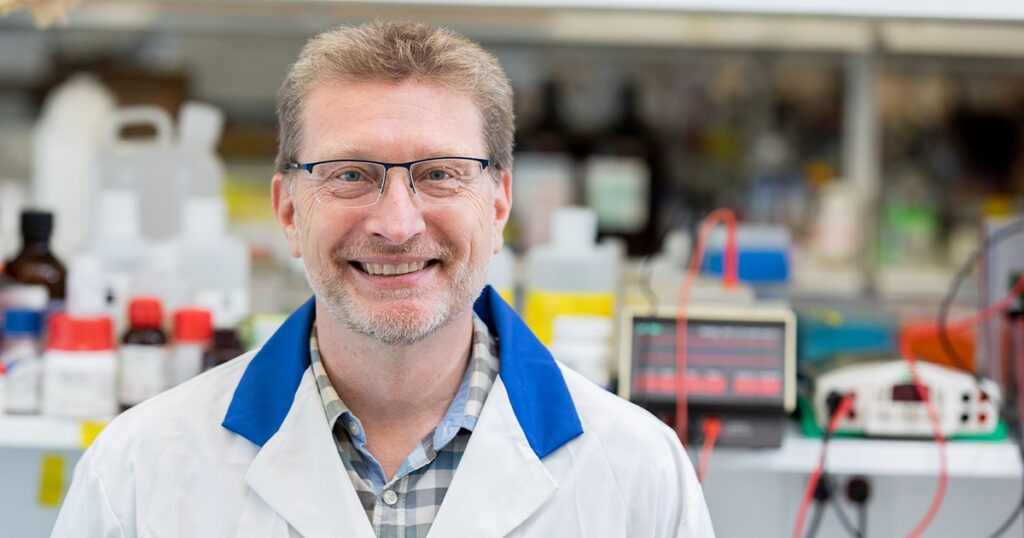Keenan scientist aims to fight fibrosis by demystifying the cells that heal our deepest wounds

Dr. Boris Hinz
As a PhD student in Bonn, Germany, Dr. Boris Hinz worked in a dermatology clinic researching skin repair.
Dr. Hinz’ experience in Bonn exposed him to conversations with patients with skin diseases, timely access to samples from those who participated in research, and collaboration with clinicians treating the very same diseases he was unpacking under a microscope.
“I saw the access: to material, to speaking with patients, to seeing the clinical problems you’re dealing with – this all changes your perspective,” Dr. Hinz said.
It was this same intersection of clinical care and research that drew him to the Keenan Research Centre for Biomedical Science at St. Michael’s, where he started this month.
Now a seasoned foundational scientist, Dr. Hinz is joining the team at the Keenan Research Centre to build on his research into the cells that respond to damage done to different organs.
The cells that Dr. Hinz studies, called myofibroblasts, create a new matrix – which can be thought of as glue at the organism level – to fix organ injuries. His research aims to contribute to new therapies that support normal wound healing but also keep healing processes in check to avoid fibrosis.
Fibrosis can be understood as too much or uncontrolled healing which eventually degenerates connective tissues, or the structural matrix of organs. According to current estimates, 45 per cent of people in North America and Europe die of some form of fibrotic disease.
We spoke with Dr. Hinz to learn more about his work and his goals at the Keenan Research Centre.
Tell us more about your research.
Imagine you have damage to your organ – the easiest example I give is a cut to your skin – which cannot stay open. You’ll get an inflammatory response to fight whatever entered your body which shouldn’t have and following this, the architecture of your skin which has been damaged has to be reestablished.
You can also have internal damages like if you overstretch your heart, if your lungs are damaged, you get microinjuries in those tissues and they’re usually repaired without us noticing it.
The problem arises when the damage is too big, like a burn incident or injury that accumulates over your lifetime and becomes chronic. In those cases, the organ is constantly injured, and cells of our body constantly try to repair the tissue by laying down sticky material – collagen matrix. In disease, they just work harder and lay down more matrix, it contracts into scar tissue, and if the scar tissue takes over normal organ tissue then the organ fails eventually or becomes dysfunctional.
That’s where our research comes in. We work on the cells, myofibroblasts, which make the new matrix to fix those damages to be able to create better therapies that reduce scarring and support normal wound healing.
What first drew you to this field?
I was always interested in the cytoskeleton, meaning the inner skeleton of cells that ‑among other functions‑ makes cells move and contract. And that attracted the attention of the scientist who discovered the fibrosis matrix making cells, which are called myofibroblasts, translating to ‘contractile fiber-making cells’.
So, I moved to Geneva where the lab was, learned all about those cells, and carried it forward in my own research.
I’m interested in how these cells become activated, how they transmit forces to make scar tissue. A good part of my brain and lab deal with biomechanics and physical mechanisms of how these cells work.
The research satisfies my own curiosity which is great. It also addresses a clinical problem – fibrosis as a group of diseases has an immense impact on patients.
Why did you decide to join the team at the Keenan Research Centre for Biomedical Science?
Talking to clinicians is an eye opener. Sometimes I’m hooked to a problem that might not actually be a problem clinically or I think of things where clinicians think there’s no solution and I realize it’s been solved and I can help relay that.
I’m only moving three blocks, but it even matters if you’re separated by a floor for discussion to happen or not. Being in a clinical setting will increase the frequency of beneficial coincidences.
What do you hope to work on at the Keenan Research Centre?
What I would hope to do at St. Mike’s is go a bit deeper into clinical research, working with patient samples and advice from clinicians. Traditionally, probably because of the way mechanical factors such as stretching affect myofibroblasts, I’m very interested in lung fibrosis as a disease group. Fibrosis of the ever contracting and mechanically challenged heart has also been in the focus of our work in the past.
I also have very good colleagues here at the Keenan who work in kidney fibrosis, and I’m intrigued by kidney fibrosis. That will be something new for me and also tying in the ways that Dr. Andras Kapus, for instance, looks at kidney fibrosis and how I look at it – there are obviously mutual interests here.
What keeps you motivated as a foundational scientist?
On the science side, what keeps me coming back is those rare events where things really do work out because they’re really gratifying. Every little success gives me an adrenaline rush. Just solving these little problems and finding something that nobody else found before and hopefully contributing to a bigger problem is very satisfying.
And then on the personal side, in the academic setting I’m working with young students and that’s just great. It keeps me flexible and mentally fresh. Seeing someone in your lab succeeding and pretending some of that success is because you interacted with that person, is also satisfying.
By: Ana Gajic
